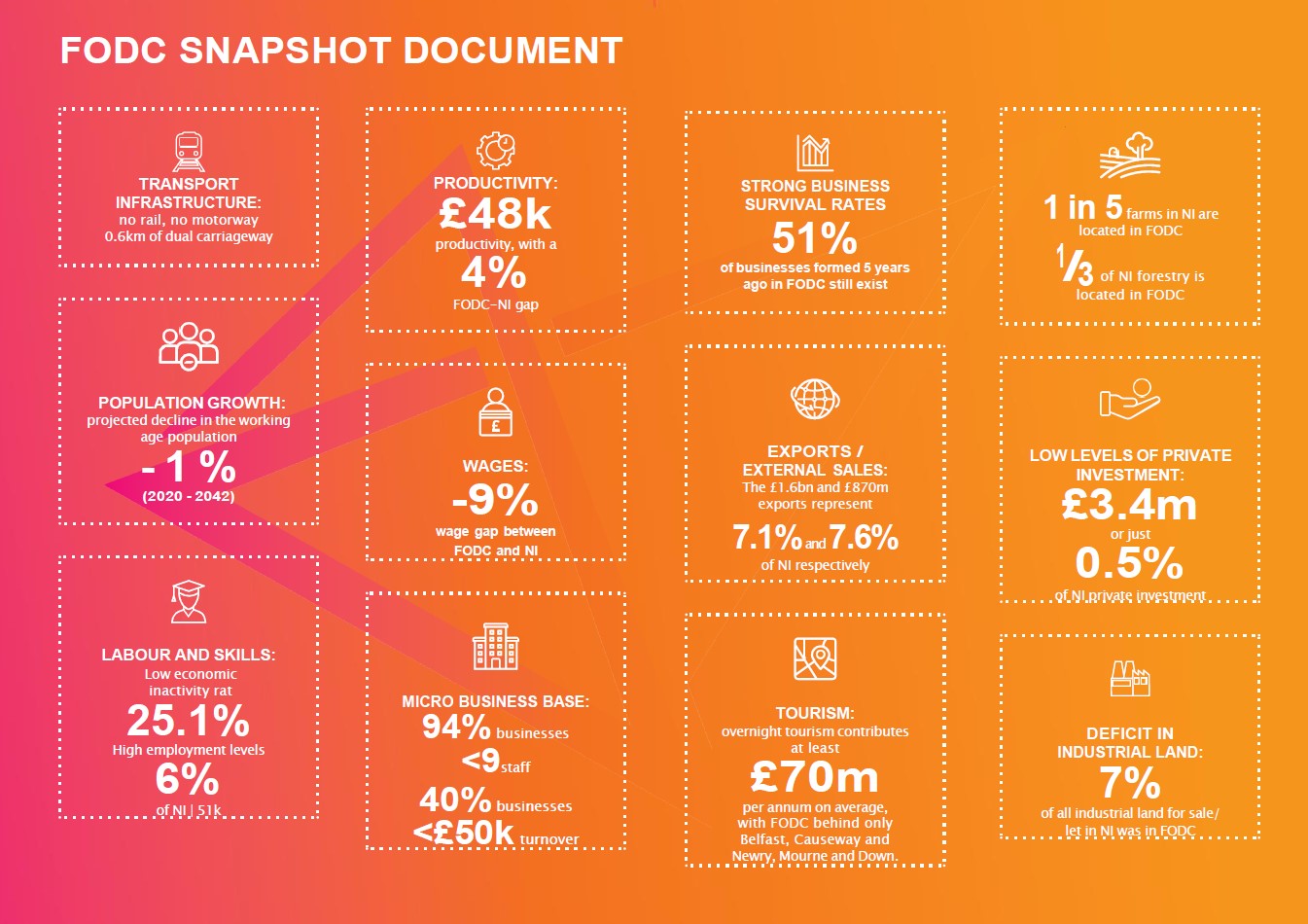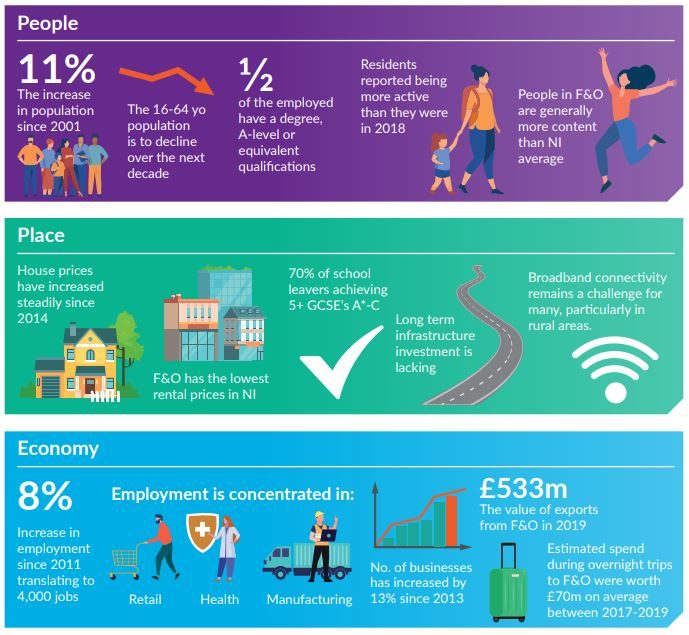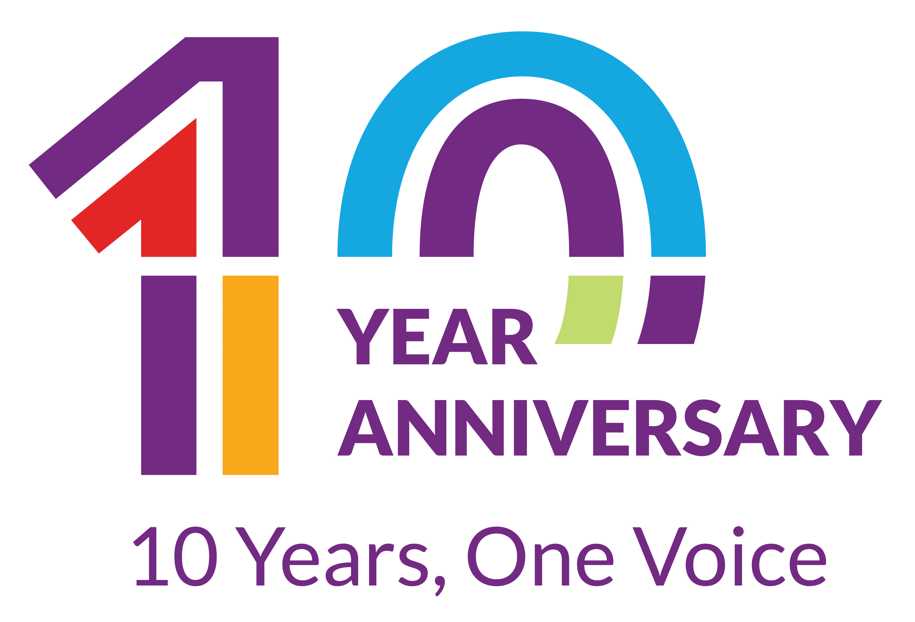Projects
Introduction
Fermanagh and Omagh District Council undertake a wide range of data-led projects. A selection of some of the most prominent projects are summarised below:
On this page:
DEA Health Profiles
The DEA Health Profiles are a compendium of publicly available health statistics, summarising the differing health needs across the DEAs in Fermanagh and Omagh. The statistics are compared between the DEA and Fermanagh and Omagh average (and Fermanagh and Omagh and the NI average) and demonstrate trends. The primary sources of statistics are the NI Health Inequalities Report 2024, Department of Health Raw Disease Prevalence 2023/24, the NI Multiple Deprivation Measure (NIMDM) 2017 and Census 2021.
Socio-Economic Profile - Autumn 2023
Perspective Economics worked in partnership with Fermanagh and Omagh District Council to undertake a socio-economic profile of the Fermanagh and Omagh District in the context of the Mid-South West Region (MSW). The themes covered include demographics, labour market and economic activity, business trade and the economy, economic contribution, tourism, housing infrastructure and deprivation. The profile examined established statistics and proprietary data, and identified longstanding issues in a new light. For example, the emphasis on ‘declining working age population’ as opposed to ‘ageing population’ presents an alternative challenge. The profile was completed in autumn 2023. The full profile and snapshot document are attached below.

Socio-Economic Profile - March 2022
The Fermanagh & Omagh district is the largest in Northern Ireland (NI) by land mass and the smallest in terms of population. It is home to 117,000 people, 70% of whom live outside the two main towns. It is an area of great natural beauty and the location of 10% of all NI’s businesses, the vast majority of these being micro-enterprises. This landscape and sparse population provide challenges in terms of service provision. This socio-economic profile of the district aims to provide an overview of the latest available data across several topic areas –from population and well-being to housing and employment. The profile draws comparisons across NI and the Republic of Ireland where possible to give a better sense of where Fermanagh & Omagh currently finds itself. We have summarised a range of indicators under the three headings of People, Place and Economy in the infographic below.

Residents' Survey 2021 - March 2021
Overall, the results from the survey are positive, with 84% of residents satisfied with the Council. This level of satisfaction compares favourably with the 67% of residents satisfied with the Council back in 2018, and benchmarks well against other Northern Ireland Councils and Councils in GB who averaged 67% in the latest survey.
The generally positive sentiment expressed by residents towards the Council is evidenced by other findings, with most (79%) residents seeing the Council as responsive to the needs of local people. On the key indicator of reputation, again the Council scores relatively well at 72% approval, which represents a significant improvement on the 2018 figure of 58%.
With the Covid-19 pandemic, the last 24 months have been challenging for all public bodies in Northern Ireland, not least local Councils. However, the survey provides reassurance that the Council’s response to the pandemic has been valued by residents, with most (87%) saying that the Council has responded well. Nevertheless the pandemic has had a significant impact on residents, with just over half (52%) reporting a negative impact on household finances.
The pandemic has also highlighted the variability in broadband provision across the District, with almost half (45%) saying that poor internet provision has been a challenge when working or studying from home. This issue of broadband connectivity was also highlighted in the focus groups with residents, with calls for the Council to continue to use its influence to ensure all residents are able to enjoy the benefits of a high quality broadband service. This is particularly important for the Council given that more services have moved online, with just under half (45%) of residents having used an online Council service. Indeed, and possibly as a result of the pandemic, the overwhelming majority (87%) of residents are supportive of the Council providing more services online where appropriate, albeit with the caveat that services still need to be accessible non-digitally to accommodate those residents who may struggle with poor broadband coverage, may have poor computer literacy, or who are not comfortable with using online methods to access services.
A more comprehensive overview of the survey results can be viewed in the download links below.
Poverty Conferences - February 2020 and March 2022
As part of our shared values and principles for our vision of Fermanagh and Omagh in 2030, the Council will prioritise resources and activities towards targeting areas where deprivation and poverty are evident so as to narrow the gap between our most and least deprived communities.
The Council hosted a number of Poverty Conferences in recent years. Poverty Conference ‘The Struggle is Real: Living on the Poverty Line – A Call to Action’ was held on Monday 24th February 2020.
The presentations and and profiles of each of the speakers can be viewed here.
A further conference, reviewing the impact of the rising cost of living on local communities in the Fermanagh and Omagh District, was held online on Tuesday 29th March 2022. The presentation can be viewed here.
Fuel, Transport and Food Poverty
Fermanagh and Omagh District Council, with funding support from the Department of Communities and the Public Health Agency, have worked in partnership with researchers at Ulster University to investigate fuel, transport and food poverty across the Fermanagh and Omagh District. Specifically, this research investigated the spatial patterns of fuel poverty (a household’s inability to keep adequately warm at a reasonable cost), transport poverty (affordability of transport) and food poverty (insufficient economic access to an adequate quantity and quality of food to maintain a nutritionally satisfactory and socially acceptable diet) to identify if rurality increases the risk of fuel, transport and/or food poverty in FODC. The study aimed to provide food, fuel and transport poverty maps in order to inform poverty alleviation policies and programmes and targeted interventions at District Electoral Area level to maximise impact and ensure those most in need are supported.
The analysis identifies small areas within Fermanagh and Omagh at risk of each type of poverty and maps areas at risk of multiple types of poverty (or ‘co-poverties’).
The full report and summary presentation are available to download below:
Transport Poverty Research
Transport Poverty is a longstanding issue in Fermanagh and Omagh. An initial set of results relating to public transport travel times to health facilities was presented to the Rural Affairs Sub-Committee in June 2022. It was agreed at the meeting to undertake an update of the analysis to cover a ‘full service’ Translink timetable and include additional health destinations such as additional GP ‘satellite practices’ within Fermanagh and Omagh and Belfast based hospitals.
The Transport Poverty Research Project was led in partnership with Community Transport providers through the Community Planning Projects.
The full paper and appendices are available to download below:
How We Use Your Rates Dashboard
The total rates paid by Fermanagh and Omagh residents and businesses is made up from a combination of the Regional Rate and the District Rate.
The Regional Rate is set by Central Government (NI Executive) whilst the District Rate is set by Fermanagh and Omagh District Council. An portion of the rates paid goes to Central Government (NI Executive) for the delivery of services including roads, education, health, emergency services, law and order and social services. The remainder of the rates paid goes to Fermanagh and Omagh District Council to fund services and investment in local infrastructure.
You can see how your rates paid are used by visiting the Council’s new interactive Rates Dashboard, available online at: https://www.fermanaghomagh.com/your-council/your-rates/how-we-use-your-rates/
Need help?
If you have any difficulty accessing the dashboards, require any support or have any queries relating to the data, please contact datascience@fermanaghomagh.com

